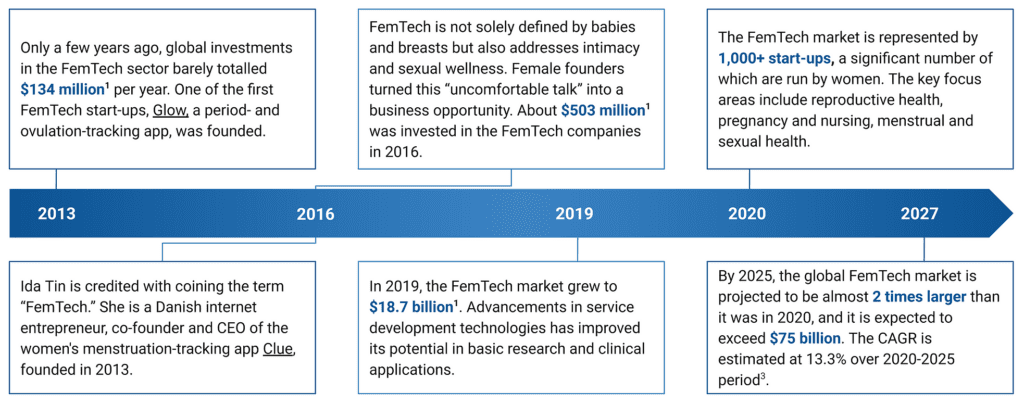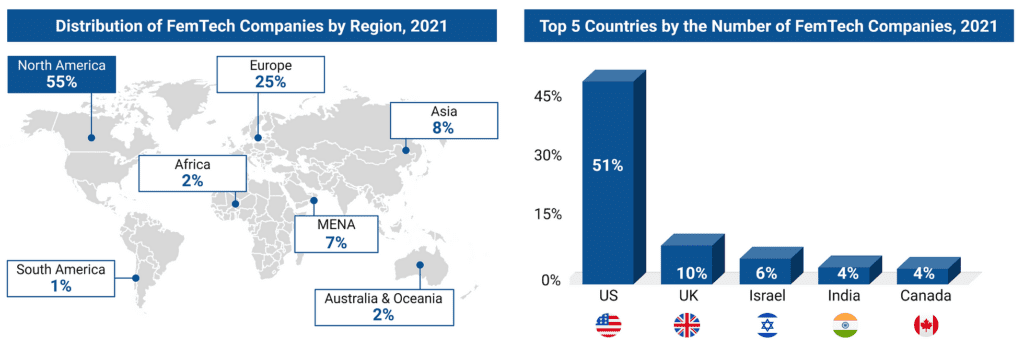Historically, women usually were in the background of society. The situation has been steadily improving in the last couple of centuries with women gaining voting rights and becoming more visible. However, the focus on women’s health in the medical field is still lacking and it is a complex issue with three main contributing factors:
As a result of this lack of focus, women were often misdiagnosed and undertreated for various conditions because there were no female-specific presentations and it contributed to the cycle of misinformation and shame regarding women’s health issues. Consequently, women have less access to resources and healthcare services that address their unique needs.
However, since the 1960s, the women’s health movement has been on the rise and brought awareness to the issues above. Women are increasingly represented in medicine and other industries, which leads to a more holistic approach to healthcare. Also, besides the general industry moving to a more equal representation, there are a lot of FemTech startups that are developing innovative solutions specifically addressing women’s health needs. A lot of work still has to be done, but at the same time, there are certainly positive shifts.
How about some statistics?

The global FemTech market size back in 2020 was valued at $40.2 billion, is projected to reach $75.1 billion next year in 2025, and the market’s potential is estimated to be $103 billion by 2030. The compound annual growth rate (CAGR) is 13.3% and looks pretty steadily growing.
At the same time, despite the growth and interest, FemTech still receives a relatively small portion of overall digital health funding. For example, between 2011 and 2020, female-focused health tech companies and solutions attracted only 3.3% of the funding in the United States, identifying a definitive funding gap. (And the USA is the leading country in FemTech, so… there’s still a lot to be done.)


Overall, the FemTech industry offers significant potential for growth and a positive impact on women’s health. While there’s room for improvement in investment and awareness, the increasing demand for innovative solutions positions FemTech as a promising field in the healthcare landscape.
FemTech Innovation Areas
There are three major areas of innovation for the startups that deal with women’s health: reproductive health, maternal health, and general women’s health. Let’s see what kind of startups are trending in each area.
If you are a founder of a FemTech startup or know of one that you love and you'd like it to be included in our article - send us a message.
Reproductive Health
APPS: Period tracking and fertility management apps
These apps allow users to track their menstrual cycles, record symptoms, and predict ovulation based on historical data. Some offer additional features like fertility planning tools, educational content, and community forums.
Examples: Clue, Flo, Glow, Femia
CONSULTATIONS: Telehealth consultations for contraception and prenatal care
These platforms connect women with healthcare providers via video chat or messaging for consultations about contraception options, birth control refills, and prenatal care needs. This can be particularly beneficial for women in areas with limited access to in-person healthcare services.
Contraception and reproductive health are a prominent subsector of FemTech in general around the world since it addresses various aspects of specifically feminine healthcare.
Examples: Maven Clinic, Hey Doctor, Planned Parenthood Direct
WEARABLES: Wearable devices for menstrual cycle monitoring and ovulation prediction
The wearables track physiological data points like basal body temperature, sleep patterns, and heart rate variability. The data is then used to predict ovulation and provide insights into the different phases of the menstrual cycle.
Examples: Ava bracelet, Oura ring, Fitbit Sense
In one of our previous articles, we've touched upon the topic of general and specialized healthcare wearables. Check it out here.
Maternal Health
Pregnancy and nursing is the largest sub-sector of FemTech in North America with a significant number of companies focusing specifically on these areas. Let’s see examples of startups that innovate here.
Remote monitoring tools for pregnancy complications
These tools allow pregnant women to monitor their health and potential complications remotely, sometimes in conjunction with healthcare providers. Examples include:
- Smart blood pressure cuffs for monitoring pre-eclampsia risk.
- Wearable devices that track fetal movement and maternal vitals to potentially detect early signs of distress.
- Home Doppler devices for listening to the fetal heartbeat, offering reassurance, and potentially identifying issues requiring further medical evaluation.
Examples: Bloomlife, HeraMED QardioArm, Peek-a-Boo Fetal Doppler
Apps for postpartum depression and lactation support
These apps address the emotional and physical challenges faced by new mothers:
- Postpartum depression apps offer mood tracking, educational resources, and access to mental health professionals via teletherapy or support groups. According to the National Institutes of Health, postpartum depression most commonly occurs within 6 weeks after childbirth. PPD occurs in about 6.5% to 20% of women. It occurs more commonly in adolescent females, mothers who deliver premature infants, and women living in urban areas.
- Lactation support apps provide information on breastfeeding techniques, latching, milk supply, and troubleshooting common challenges. They may also connect users with lactation consultants and offer a forum for peer support.
Examples: Mylo, Psi Mom, Lactation Link
Breastfeeding tracking and support platforms
These platforms help mothers track and manage breastfeeding sessions:
- Users can log feeding times, duration on each breast, diaper changes, and pump sessions. When the mother is (or both parents are) overwhelmed with the changes in their lives, it’s important to have something as a guide and a reminder about new routines.
- Some apps offer insights into milk supply patterns and potential growth spurts.
- They can also connect mothers with lactation consultants or breastfeeding support groups for personalized guidance and troubleshooting.
Examples: Baby Tracker by Sprout, Huckleberry, Feeding Friend
General Women’s Health
Mental health apps tailored to women’s needs
These apps address mental health concerns prevalent in women, such as anxiety, depression, and stress related to hormonal fluctuations, body image, and societal pressures. They often incorporate mindfulness exercises, relaxation techniques, and cognitive-behavioral therapy (CBT) tools specifically tailored to women’s experiences.
Examples: Calm for Women, Shine, Youper
Platforms for tracking symptoms of chronic conditions like endometriosis
These platforms empower women with endometriosis to track their symptoms (pain, fatigue, bleeding patterns), identify triggers, and manage their condition. Some offer educational resources, connect users with support groups, and allow them to share experiences with others battling the same condition.
Examples: My Endometriosis Team, Clue Period Tracker (with Endometriosis Tracking Feature), Endometriosis.net
Tools for sexual wellness education and access to resources
These platforms provide education on female anatomy, sexual health, and sexual pleasure. They offer resources like articles, videos, and interactive tools to address topics like contraception methods, sexually transmitted infections (STIs), healthy sexual relationships, and body positivity. Some platforms also connect users with healthcare providers for sexual health consultations.
Examples: Scarleteen, Planned Parenthood, Intimina
Tools that help early breast cancer detection
MIT researchers are revolutionizing early breast cancer detection with a novel wearable ultrasound device. Designed for at-home use, this technology could enable high-risk patients to monitor for tumors in the intervals between routine mammograms, potentially leading to improved survival outcomes. Statistics show that if detected early, the survival rate for breast cancer is almost 100%.
Benefits of FemTech Startups
FemTech is transforming the healthcare landscape by addressing the specific needs of women. Here’s how it offers a multitude of benefits:
- Improved access to healthcare:
- Reaching underserved communities: FemTech solutions like telehealth consultations and mobile apps overcome geographical barriers and offer crucial healthcare services to women in remote areas or those facing transportation challenges.
- Bridging the gap for busy schedules: Online platforms and digital tools fit seamlessly into women’s busy lives, allowing them to manage their health conveniently without extensive in-person appointments.
- Statistics: A 2023 study by McKinsey & Company found that telemedicine use soared during the pandemic, with a significant increase in utilization of women’s health services like prenatal care and mental health consultations.
- Empowerment and education:
- Taking control of health: FemTech apps and platforms equip women with knowledge about their bodies and menstrual cycles, fertility, and overall well-being. This empowers them to make informed decisions about their health and seek necessary medical attention.
- Breaking the silence: Open communication platforms within FemTech apps and online communities allow women to share experiences, ask questions, and destigmatize sensitive health issues.
- Personalized and data-driven healthcare:
- Tailored solutions: FemTech utilizes user data (period tracking, symptom monitoring) to offer personalized insights, recommendations, and predictions related to health and well-being.
- Proactive management of chronic conditions: FemTech platforms for tracking symptoms of conditions like endometriosis allow women to identify patterns, manage flare-ups, and work collaboratively with healthcare providers for better treatment plans.
- Destigmatization of women’s health issues:
- Normalizing conversations: FemTech platforms encourage open discussions about menstruation, sexual health, and other women’s health topics. This reduces shame and fosters a sense of community and shared experiences.
- Breaking down taboos: By addressing previously neglected areas and providing accessible educational resources, FemTech contributes to a more inclusive and informed healthcare environment.
FemTech’s impact extends beyond individual users. It holds the potential to transform healthcare systems by:
- Reducing healthcare costs through preventive care measures and early detection of potential issues.
- Improving healthcare outcomes through personalized treatment plans and informed patient participation.
- Empowering healthcare providers with data-driven insights into women’s health trends and needs. Besides, women feel more motivated to turn to healthcare providers for specific issues.
Overall, FemTech is a powerful force for positive change in women’s healthcare, offering accessibility, education, and personalized tools for women to take charge of their well-being.
FemTech Challenges and Considerations
There are numerous benefits, but there are also challenges and things that should be considered when we are talking about FemTech and healthcare in general.
- Data Privacy and Security:
- Sensitive Information: FemTech apps often collect personal health data related to menstrual cycles, fertility, sexual health, and chronic conditions. Ensuring robust security measures and user privacy is paramount.
- Data Ownership and Transparency: It’s crucial for FemTech companies to clearly define data ownership practices and how user information will be utilized. Transparency regarding potential data sharing with third parties is essential for building user trust.
- 2. Accessibility and Affordability:
- Digital Divide: Not all women have access to smartphones, internet connectivity, or the digital literacy required to utilize FemTech solutions. This can exacerbate existing health disparities and limit inclusivity.
- Cost Considerations: Subscription fees or in-app purchases can create barriers for low-income women. Initiatives promoting free or subsidized access to essential FemTech tools are necessary.
- 3. Regulation and Integration with Traditional Healthcare Systems:
- Evolving Regulatory Landscape: Regulations governing data privacy, telemedicine practices, and digital health tools are still evolving. FemTech companies need to stay updated and compliant to operate effectively.
- Integration with Healthcare Providers: Seamless integration with existing healthcare systems is crucial for data sharing, ensuring continuity of care, and allowing healthcare providers to utilize FemTech insights for better patient management.
These challenges highlight the need for collaboration between FemTech companies, policymakers, healthcare institutions, and patient advocacy groups. By working together, they can ensure FemTech reaches all women and unlocks its full potential to revolutionize healthcare.
The Future of FemTech: A Glimpse into a Healthier Tomorrow
FemTech is a rapidly evolving field brimming with potential. Here’s a look at what the future holds:
The Power of AI and Machine Learning
Advanced Analytics: Integration with AI and machine learning can unlock a new level of personalized insights. Imagine AI-powered tools that analyze menstrual cycle data to predict potential fertility issues or utilize symptom tracking to identify early signs of chronic conditions.
Enhanced User Experience: Chatbots powered by AI can offer 24/7 support, answer personalized health questions, and provide real-time guidance based on individual needs.
Continued Innovation and Addressing Unmet Needs
Focus on Diverse Needs: The FemTech industry will continue to expand, addressing the specific health concerns of women across different age groups, ethnicities, and socioeconomic backgrounds.
Bridging the Gap: FemTech solutions will likely integrate with wearable devices and biosensors to collect even more comprehensive health data, further empowering women with a holistic view of their well-being.
FemTech: A Catalyst for Gender Equality in Healthcare
Closing the Gap: By prioritizing women’s health needs and normalizing conversations, FemTech can contribute significantly to closing the gender gap in healthcare access and outcomes.
Empowering Women’s Voices: FemTech platforms can foster a community where women can share experiences, advocate for improved healthcare policies, and influence research priorities related to women’s health.
Conclusion: What’s next?
There is still limited awareness about FemTech. Google Trends data suggests that public awareness and user adoption of “FemTech” as a term remains relatively low compared to other healthtech terms. However, as we have noted at the beginning of our article, the market is definitely growing.
One thing we have to understand: FemTech is not just a trend; it’s a revolution in women’s healthcare. By addressing long-standing issues of accessibility, education, and data-driven solutions, FemTech empowers women to take control of their health and well-being. As the field continues to evolve through technological advancements and collaborative efforts, FemTech has the potential to create a future where all women have access to the care they deserve.
In our next article, we’ll talk about the healthtech startups that focus on male health and that is another important topic because it brings more equality to various specific health issues and allows us to tackle them appropriately.
We’ve included a lot of links in our article so feel free to learn more about specific FemTech startups and support the industry. Our health is the only true wealth that brings us well-being. Therefore, let’s invest in something that matters.
Book a call with our experts
Feel free to drop us a message regarding your project – we’re eagerly looking forward to hearing from you!


